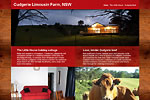This section is: Web.
Web design: the long story

The short story was:
- it should look good
- it should work.
The long story is set out below. For most readers, this will be too much information. You might like to skip to the website portfolio section.
1. It should look good.
At the moment, Savvy Web Design aims for simple, functional design.
Design for design's own sake can be counterproductive. The most important part of your website is the message, not the medium. (If you don't have anything to say, then why do you need a website?)
However, one of the functions of good design is to give your clients a favourable impression of your business — it's therefore necessary to find a balance between pretty and utilitarian. To judge whether Savvy Web Design finds a balance that's appropriate to your needs, please have a look at the websites in the sample section.
2. It should work.
Your website "works" when it gets your message in front of your visitor, and your message is shown in the way you want it to be shown.
Good text content is one element of that: clear, well-organised text that’s easy to understand.
Another element is good code behind the scenes. Code could be considered the nuts and bolts of websites.
A major concern in writing website code is cross-browser compatibility. That’s the science of constructing your web pages so they display consistently and work consistently, regardless of where and how they’re being accessed. The text below goes into a little more detail, or you can scroll down if you prefer to skip it.
(It should work for most of the people, most of the time.)
It's impossible to make your website look and function exactly the same for everyone who visits it.
This is mainly because different browser software will interpret the code (the nuts & bolts of websites) differently. The best-known example of this is that web pages look slightly different in Microsoft Internet Explorer than in other browsers such as Firefox or Chrome.
But even variables like different versions of the same browser, personalised browser settings, range of fonts available on the visitor's computer, and monitor settings, will alter the appearance — and to some extent the functioning — of the most carefully-coded web page.
The most important thing is that a website must make its content accessible, regardless of how it looks; and this too is affected by browser type and settings.
The ideal, then, is to make the appearance and functioning of your website fall within an acceptable range for the majority of visitors.
To achieve this ideal, things to avoid include recent additions to HTML, overreliance on Javascript, and large minimum page dimensions, on the grounds that these approaches exclude a fair percentage of potential visitors.
Savvy Web Design websites also minimise the use of Flash, a technology which is a barrier to accessibility. To explain briefly, Flash content is relatively slow to load, is invisible to some search engines, excludes any visitor whose browser doesn't have the Flash plugin installed, and does not respond to the traditional controls used when navigating websites (the "back" button, for example). Websites that incorporate instances of Flash content are taking a gamble, but websites that rely 100% on Flash for navigation and content delivery are disasters.
To date, no Savvy Web Design sites have been designed for direct compatibility with text-to-speech browsers for the visually impaired, nor for direct compatibility with viewing on mobile devices. This is simply due to client specifications.
Incidentally, most Savvy Web Design websites are standards-compliant, although some of them forego standards compliance in the interests of practicality. (This issue itself would require a page or more of explanation; helpful links are due to be added to the Further Reading page.)
One of the things website owners most frequently ask about is search engine optimisation, or SEO. SEO is the product of good text content and good code, and it's included free of charge with Savvy Web Design websites. SEO is a complex area; for more information see the Further Reading page under the heading Search Engines.
And lastly, a good website should be fast-loading. Even today, this remains an issue. Your website's visitors won't all have fast connections with unlimited bandwidth and download allowance. And most importantly, they don't want to wait to receive your message. Therefore, no pointless Flash presentations, no bloated graphics, and a minimum of Java tricks. Code should also be kept trim, including the avoidance of huge keyword lists (in any case, many search engines ignore keywords in excess of a certain quantity).
Speaking of which...
Still here? We told you it was the long story. If that wasn't enough reading for you, see the Articles section for other writers' discussions of these issues. Or head on to the sample websites section.
WEB DESIGN | WEBSITE PORTFOLIO | DOMAINS & HOSTING | WEB FAQ | FURTHER READING
